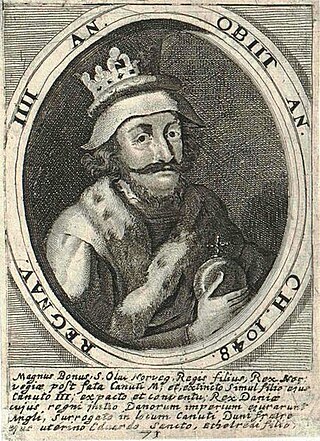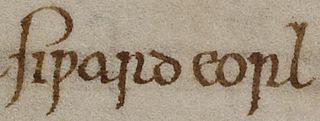Related Research Articles
Godwin of Wessex was an English nobleman who became one of the most powerful earls in England under the Danish king Cnut the Great and his successors. Cnut made Godwin the first Earl of Wessex. Godwin was the father of King Harold II and of Edith of Wessex, who in 1045 married King Edward the Confessor.

Emma of Normandy was a Norman-born noblewoman who became the English, Danish, and Norwegian queen through her marriages to the Anglo-Saxon king Æthelred the Unready and the Danish king Cnut the Great. A daughter of the Norman ruler Richard the Fearless and Gunnor, she was Queen of the English during her marriage to King Æthelred from 1002 to 1016, except during a brief interruption in 1013–14 when the Danish king Sweyn Forkbeard occupied the English throne. Æthelred died in 1016, and Emma married Sweyn's son Cnut. As Cnut's wife, she was Queen of England from their marriage in 1017, Queen of Denmark from 1018, and Queen of Norway from 1028 until Cnut died in 1035.

Edward the Confessor was an Anglo-Saxon English king and saint. Usually considered the last king of the House of Wessex, he ruled from 1042 until his death in 1066.

Harthacnut, traditionally Hardicanute, sometimes referred to as Canute III, was King of Denmark from 1035 to 1042 and King of the English from 1040 to 1042.

Harold I, also known as Harold Harefoot, was regent of England from 1035 to 1037 and King of the English from 1037 to 1040. Harold's nickname "Harefoot" is first recorded as "Harefoh" or "Harefah" in the twelfth century in the history of Ely Abbey, and according to some late medieval chroniclers it meant that he was "fleet of foot".

Magnus Olafsson, better known as Magnus the Good, was King of Norway from 1035 and King of Denmark from 1042 until his death in 1047.
Lyfing was an Anglo-Saxon Bishop of Wells and Archbishop of Canterbury. He was abbot of Chertsey Abbey before becoming bishop at Wells. His appointment to Canterbury came at a time of Danish invasions of England, and he was unable to act as archbishop for a time due to Danish activity. When Cnut, the Danish king, became king of England, Lyfing likely consecrated the new king. Lyfing was known as a wise man and gave gifts to his church and oversaw repairs to his cathedral before his death in 1020.
Lyfing of Winchester was an Anglo-Saxon prelate who served as Bishop of Worcester, Bishop of Crediton and Bishop of Cornwall.
Leofric was a medieval Bishop of Exeter. Probably a native of Cornwall, he was educated on the continent. At the time Edward the Confessor was in exile before his succession to the English throne, Leofric joined his service and returned to England with him. After he became king, Edward rewarded Leofric with lands. Although a 12th-century source claims Leofric held the office of chancellor, modern historians agree he never did so.

Stigand was an Anglo-Saxon churchman in pre-Norman Conquest England who became Archbishop of Canterbury. His birth date is unknown, but by 1020 he was serving as a royal chaplain and advisor. He was named Bishop of Elmham in 1043, and was later Bishop of Winchester and Archbishop of Canterbury. Stigand was an advisor to several members of the Anglo-Saxon and Norman English royal dynasties, serving six successive kings. Excommunicated by several popes for his pluralism in holding the two sees, or bishoprics, of Winchester and Canterbury concurrently, he was finally deposed in 1070, and his estates and personal wealth were confiscated by William the Conqueror. Stigand was imprisoned at Winchester, where he died.
Robert of Jumièges was the first Norman Archbishop of Canterbury. He had previously served as prior of the Abbey of St Ouen at Rouen in Normandy, before becoming abbot of Jumièges Abbey, near Rouen, in 1037. He was a good friend and adviser to the king of England, Edward the Confessor, who appointed him bishop of London in 1044, and then archbishop in 1051. Robert's time as archbishop lasted only about eighteen months. He had already come into conflict with the powerful Earl Godwin and, while archbishop, made attempts to recover lands lost to Godwin and his family. He also refused to consecrate Spearhafoc, Edward's choice to succeed Robert as Bishop of London. The rift between Robert and Godwin culminated in Robert's deposition and exile in 1052.
Ælfgifu of Northampton was the first wife of Cnut the Great, King of England and Denmark, and mother of Harold Harefoot, King of England. She was regent of Norway from 1030 to 1035.

Leofric was an Earl of Mercia. He founded monasteries at Coventry and Much Wenlock and was a very powerful earl under King Cnut and his successors. Leofric was the husband of Lady Godiva.

Siward or Sigurd was an important earl of 11th-century northern England. The Old Norse nickname Digri and its Latin translation Grossus are given to him by near-contemporary texts. It is possible Siward may have been of Scandinavian or Anglo-Scandinavian origin, perhaps a relative of Earl Ulf, although this is speculative. He emerged as a regional strongman in England during the reign of Cnut. Cnut was a Scandinavian ruler who conquered most of England in the 1010s, and Siward was one of many Scandinavians who came to England in the aftermath, rising to become sub-ruler of most of northern England. From 1033 at the latest, he was in control of southern Northumbria, present-day Yorkshire, governing as earl on Cnut's behalf.
Grimketel was an English clergyman who went to Norway as a missionary and was partly responsible for the conversion of Norway to Christianity. He initiated the beatification of Saint Olaf. On his return to England he became Bishop of Selsey and also for a time Bishop of Elmham. He was accused, by some, of being guilty of simony.
Eadsige, was Archbishop of Canterbury from 1038 to 1050. He crowned Edward the Confessor as king of England in 1043.
Ælfric Puttoc was Archbishop of York from 1023 to his death, and briefly Bishop of Worcester from 1040 to 1041. He may have crowned Harold Harefoot in 1036, and certainly assisted in that king's disinterment in 1040 and at the coronation of Edward the Confessor in 1043. He founded houses of canons and encouraged the cult of John of Beverley.

The Old Minster was the Anglo-Saxon cathedral for the English diocese of Wessex and then Winchester from 660 to 1093. It stood on a site immediately north of and partially beneath its successor, Winchester Cathedral.
Osgod Clapa, also Osgot, was a nobleman in Anglo-Saxon England during the reigns of Kings Cnut the Great, Harold Harefoot, Harthacnut, and Edward the Confessor. His name comes from the Old Danish Asgot, the byname Clapa perhaps meaning coarse, or rough, in Old Norse. He was a major landowner in East Anglia during a period in which no Ealdorman was appointed to the region. He held the post of staller, that is constable or master of the royal stables. In 1046 he was banished, and in 1054 he died.

The Abbey of the Holy Trinity at Fécamp, commonly known as Fécamp Abbey, is a Benedictine abbey in Fécamp, Seine-Maritime, Upper Normandy, France.
References
- Crook, John (September 2022). "Medieval Royal and Episcopal Burials in Winchester Cathedral". The Antiquaries Journal. 102: 134–162. doi:10.1017/S0003581521000287.
- Fryde, E. B.; Greenway, D. E.; Porter, S.; Roy, I. (1996). Handbook of British Chronology (Third revised ed.). Cambridge: Cambridge University Press. ISBN 0-521-56350-X.
- Maddicott, J. R. (2004). "Edward the Confessor's Return to England in 1041". English Historical Review. CXIX (482). Oxford University Press: 650–666. doi:10.1093/ehr/119.482.650.
- Mason, Emma (2004). "Ælfwine (d. 1047)". Oxford Dictionary of National Biography. Oxford: Oxford University Press.(subscription or UK public library membership required)
- Smith, Mary Frances (2001). Lewis, C. P. (ed.). The Preferment of Royal Clerks in the Reign of Edward the Confessor. Haskins Society Journal: Studies in Medieval History. Vol. 9. Woodbridge, UK: Boydell. pp. 159–174. ISBN 0-85115-831-5.
- Stafford, Pauline (2001). Queen Emma & Queen Edith: Queenship and Women's Power in Eleventh-Century England. Oxford: Blackwell.
